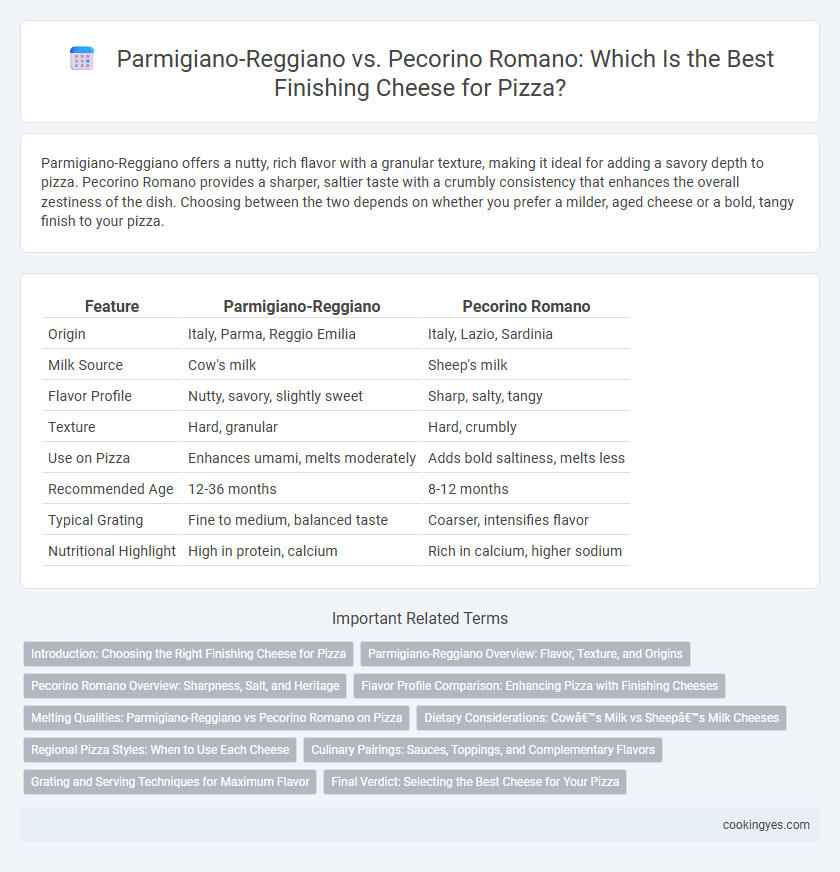Parmigiano-Reggiano offers a nutty, rich flavor with a granular texture, making it ideal for adding a savory depth to pizza. Pecorino Romano provides a sharper, saltier taste with a crumbly consistency that enhances the overall zestiness of the dish. Choosing between the two depends on whether you prefer a milder, aged cheese or a bold, tangy finish to your pizza.
Table of Comparison
| Feature | Parmigiano-Reggiano | Pecorino Romano |
|---|---|---|
| Origin | Italy, Parma, Reggio Emilia | Italy, Lazio, Sardinia |
| Milk Source | Cow's milk | Sheep's milk |
| Flavor Profile | Nutty, savory, slightly sweet | Sharp, salty, tangy |
| Texture | Hard, granular | Hard, crumbly |
| Use on Pizza | Enhances umami, melts moderately | Adds bold saltiness, melts less |
| Recommended Age | 12-36 months | 8-12 months |
| Typical Grating | Fine to medium, balanced taste | Coarser, intensifies flavor |
| Nutritional Highlight | High in protein, calcium | Rich in calcium, higher sodium |
Introduction: Choosing the Right Finishing Cheese for Pizza
Parmigiano-Reggiano offers a nutty, savory flavor with granular texture, enhancing pizza with its rich umami and melting qualities. Pecorino Romano provides a sharper, saltier profile derived from sheep's milk, creating a bold finishing touch that intensifies pizza's taste. Selecting between Parmigiano-Reggiano and Pecorino Romano depends on desired flavor balance and regional authenticity in pizza preparation.
Parmigiano-Reggiano Overview: Flavor, Texture, and Origins
Parmigiano-Reggiano, known as the "King of Cheeses," originates from specific provinces in Italy and offers a complex nutty and fruity flavor profile ideal for finishing pizzas. Its granular texture and rich umami amplify the overall taste without overpowering other toppings, making it a preferred choice over the sharper, saltier Pecorino Romano. This cheese's aging process, typically 24-36 months, contributes to its unique depth and enhances the savory experience of a well-crafted pizza.
Pecorino Romano Overview: Sharpness, Salt, and Heritage
Pecorino Romano is a hard, salty cheese known for its sharp, tangy flavor, making it a distinctive finishing choice for pizza. Made from sheep's milk, it offers a robust taste profile that complements rich tomato sauces and savory toppings. Its centuries-old heritage in Italian cuisine highlights its role in elevating dishes with a bold and salty bite, contrasting with the nuttier, milder Parmigiano-Reggiano.
Flavor Profile Comparison: Enhancing Pizza with Finishing Cheeses
Parmigiano-Reggiano offers a nutty, savory, and slightly granular texture that melts smoothly on hot pizza, enhancing umami with its complex, aged flavors. Pecorino Romano delivers a sharper, saltier punch with a bold, tangy intensity derived from sheep's milk, providing a robust contrast that cuts through rich toppings. Choosing between these finishing cheeses depends on desired flavor balance: Parmigiano-Reggiano adds subtle depth, while Pecorino Romano boosts a vibrant, savory sharpness.
Melting Qualities: Parmigiano-Reggiano vs Pecorino Romano on Pizza
Parmigiano-Reggiano melts smoothly on pizza, creating a creamy texture that enhances the overall flavor profile without overpowering the other ingredients. Pecorino Romano, known for its saltiness and firm texture, does not melt as evenly, often resulting in sharper, crumblier patches that add a bold, tangy contrast. Choosing Parmigiano-Reggiano offers a balanced melt and rich umami, while Pecorino Romano delivers a more intense taste with a less uniform melt.
Dietary Considerations: Cow’s Milk vs Sheep’s Milk Cheeses
Parmigiano-Reggiano, made from cow's milk, typically contains less fat and salt compared to Pecorino Romano, which is derived from sheep's milk and is known for its robust, saltier flavor suitable for those monitoring sodium intake. Cow's milk cheeses like Parmigiano-Reggiano often have lower allergenic potential than sheep's milk alternatives, making them preferable for people with certain dairy sensitivities. Pecorino Romano's higher protein and calcium content may benefit individuals seeking nutrient-dense options, but its stronger taste and saltiness might not suit all dietary restrictions.
Regional Pizza Styles: When to Use Each Cheese
Parmigiano-Reggiano enhances Neapolitan and Margherita pizzas with its nutty, aged flavor, complementing fresh tomato sauce and basil. Pecorino Romano's sharp, salty profile suits Roman-style pizzas like Pizza Bianca and Pizza al Taglio, adding a bold finish to olive oil-based or simple toppings. Regional pizza styles dictate the ideal finishing cheese, balancing traditional flavors to elevate authentic Italian pizza experiences.
Culinary Pairings: Sauces, Toppings, and Complementary Flavors
Parmigiano-Reggiano enhances pizza with its nutty, umami-rich flavor, pairing exceptionally well with tomato-based sauces, basil, and prosciutto toppings, adding depth and complexity. Pecorino Romano offers a sharp, salty profile that complements robust, spicy sauces, sausage, and olives, delivering a bold contrast that elevates bold, savory flavors. Both cheeses provide a distinct texture when grated over finished pizzas, balancing richness and enhancing overall taste profiles in diverse culinary pairings.
Grating and Serving Techniques for Maximum Flavor
Parmigiano-Reggiano offers a granular texture that grates finely, creating light, fluffy shavings ideal for evenly distributing its nutty, umami flavor atop pizza. Pecorino Romano's harder, saltier nature requires a coarser grate, producing sharper, more intense flakes that stand out on rich tomato sauces and robust toppings. For maximum flavor, sprinkle Parmigiano-Reggiano after baking to preserve its delicate aroma, while Pecorino Romano blends well both during cooking and as a finishing touch to enhance complexity.
Final Verdict: Selecting the Best Cheese for Your Pizza
Parmigiano-Reggiano offers a rich, nutty flavor and granular texture that melts smoothly atop pizza, enhancing its complexity without overpowering the other ingredients. Pecorino Romano, with its sharper, saltier profile and crumbly consistency, provides a bold finishing touch that stands out on hearty, robust pizzas. Choosing between them depends on desired taste intensity: Parmigiano-Reggiano for balanced, delicate refinement; Pecorino Romano for a pronounced, savory punch.
Parmigiano-Reggiano vs Pecorino Romano for finishing cheese Infographic

 cookingyes.com
cookingyes.com